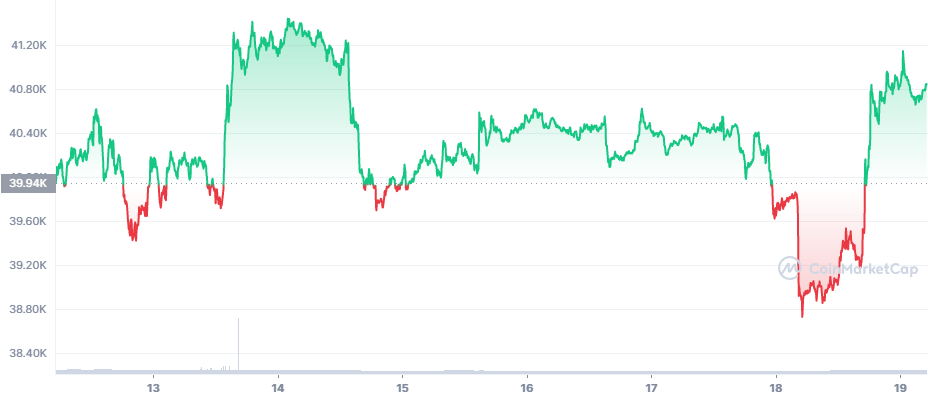Bitcoin (BTC) Goes for Flash Crash, Fast Recovery

Bitcoin (BTC) fell as low as $39,005 on Monday, later aiming to recover the $40,000 level. The day moved with extreme volatility, as BTC only took minutes to shift to $40,765.50, expanding the daily swing of volatility. A move like that can wipe out both long and short positions. BTC also expanded its market cap dominance to 41.1%. Later, BTC returned to its levels from the previous days, trading at $40,846.68.
BTC fell under the $40,000 support level in a long-awaited backtracking. In the new week, BTC fell after the slow holiday weekend managed to keep some of the gains. After a rally at the beginning of the month, April is turning into a bearish month, not repeating the rally of 2021. BTC may also face uncertainty from macro factors, though for now it benefits as a tool against actual and expected inflation.
But the drop dragged down altcoins, pushing Ethereum (ETH) under $3,000 briefly. The latest events were considered an example of a short-term fakeout, with the effect of sweeping out leveraged positions. The fast recovery showed BTC was still safe from a bigger dip. BTC for now held above the $38,000 level, which could break down to the $35,000-$32,000 range.
This time, the relatively low price and a delayed rally still translates into ongoing accumulation of BTC. The lack of a rally to potential new highs is attracting long-term buyers that are aiming to lock in physical coins.
In the past month, the market also saw an inflow of 2.7B Tether (USDT), which are still flowing into exchanges and at least supporting prices. The Bitcoin rainbow chart at this price suggests the asset is still cheap, on the verge of triggering another accumulation period.
Will the BTC ETF Matter
The launch of a Bitcoin ETF is a secondary factor for price action. The US Securities and Exchange Commission has approved products based on BTC derivatives.
The statement on a potential spot BTC ETF may come in June, with the goal of converting Grayscale’s Bitcoin Trust into an ETF vehicle.
Grayscale’s vehicles trade at a discount to spot BTC, with a price of $29.01 per share. This translates into a much lower presumed BTC price based on the coins contained in each share. Grayscale trading at a premium has happened in the past, signaling more robust mainstream interest, which has now slowed down. Grayscale is also not an important source as more retail buyers learn to use wallets and hold BTC directly.
Why is BTC Falling
One of the reasons is the expectation for attacking leveraged positions, which may extend the short-term slide. Short-term predictions see BTC revisiting $37,000, though there is caution in longing the asset even at that level. On Monday, there were signs of attacking short positions expecting a drop under $39,000.
When BTC moved fast by a few hundred dollars, it was enough to liquidate $29.9B in value. More than 63% of trades on the Binance futures exchange caused short liquidations. The small bounce close to $40,000 also erased open interest as derivative trading turned even more cautious.
In a day, the Crypto Fear and Greed Index slid from 28 to 24 points, signaling the increasing caution and expectations of more rapid price moves in either direction.
BTC trading volumes, as predicted, rose to their usual weekday levels above $30B in 24 hours, while USDT trading was again above $60B in 24 hours. Stablecoins encompass multiple assets, causing anomalous rallies.
In a best-case scenario, BTC is close to bottoming out, after erasing nearly 20% of its value in a short time span. Still, there are indicators for BTC entering a zone of risk with more uncertainty.
Can Altcoins Drive the Recovery
Altcoin traders may also turn to caution, as smaller assets also go through more dramatic corrections. Within days, Terra (LUNA) retreated from its recent rally and dipped to $85. Solana (SOL) also stopped its trek and is now barely above $100.
Avalanche (AVAX) stagnated above $75 as the market moved on from the news of recent partnerships and boosted stablecoin liquidity.
Monero (XMR) was an outlier as the coin gained more than 14% week-on-week while other assets moved sideways or down.
XMR has spent a long time away from its higher valuations and may attempt to become an influential asset again. XMR rallied to a peak at $264.09 for the day, later retreating to about $255. XMR started its expansion last month, moving up from just under $200.
ZCash (ZEC), another anonymous-type coin, rallied to $150.59. ZEC bounced from a one-month low, with the potential to recover the $200 level. ZEC reawakened after recent mentions from Grayscale Capital on the potential return of privacy coins.

Uphold makes buying crypto with popular currencies like USD, EUR and GBP very simple with its convenient options to swap between crypto, fiat, equities, and precious metals.

With over 50 coins and an obsession with security, Kraken is one of the safest places to buy and trade crypto.

Kraken has a good reputation for security and protection of your funds and operates across the USA (except NY), Canada, the EU and Japan

Based in Charleston, South Carolina. Serves over 184 countries and has done over $4 billion in transactions. Offers convenient options to swap between crypto, fiat, equities, and precious metals.

What are the most common scam coins and how much have they got away with in the past, plus some tips on how to avoid these scam coins.

The basics of cryptocurrency portfolios and how to get started in tracking your crypto holdings

A multi-utility asset, linked to the diverse activities of the Binance Exchange. A token to pay trading fees, as well as participate in new asset sales, BNB now runs on a proprietary blockchain.

The first cryptocurrency. It has limitations for transactions but it is still the most popular being secure, trusted and independent from banks and governments.